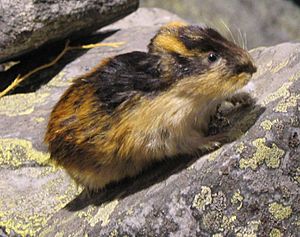Norway lemming facts for kids
Quick facts for kids Norway lemming |
|
|---|---|
 |
|
| Conservation status | |
| Scientific classification | |
| Genus: |
Lemmus
|
| Species: |
lemmus
|
 |
|
| Norway lemming range | |
| Synonyms | |
|
Mus lemmus Linnaeus, 1758 |
|
The Norway lemming (also called the Norwegian lemming) is a small rodent. Its scientific name is Lemmus lemmus. You can find it in northern Fennoscandia, which includes countries like Norway, Sweden, Finland, and parts of Russia. It's special because it's the only animal with a backbone that lives only in this area. Norway lemmings live in cold, open lands called tundra and on mountainsides (fells). They like to live near water. These lemmings mostly eat plants like sedges, grasses, and moss. They are active both day and night, taking naps between their busy times.
Contents
Where Do Norway Lemmings Live?
Norway lemmings live across a wide area. Their home stretches from western Norway all the way east to the Kola Peninsula in Russia. There's also a special group of lemmings on Novaya Zemlya island. Scientists are still studying if these lemmings are the same species. If they are, it would make the lemming's range even bigger!
What Do Norway Lemmings Look Like?
Mainland Norway lemmings have a striking look. They have a bold pattern of black and yellow-brown fur. This pattern can be a bit different for each lemming. They grow to about 15.5 centimeters (about 6 inches) long. Their tail is very short, only about 1 to 1.9 centimeters (less than an inch). A Norway lemming can weigh up to 130 grams (about 4.5 ounces).
How Do Norway Lemmings Behave?
Norway lemmings are famous for their changing numbers. Their population goes through a big cycle every three to four years. Their numbers can grow very high. Then, suddenly, many lemmings die, and the population drops sharply. After that, the numbers start to grow again.
Life in Different Seasons
Norway lemmings spend the winter safe under the snow. They build cozy nests there. When spring comes, the snow starts to melt. This means they must move to new places. Sometimes they go to higher ground where the snow is still firm. More often, they move to lower areas for the summer. In autumn, they must plan their return carefully. They wait until there's enough snow on higher ground for their burrows. They also need to leave before the lowlands get too cold and icy.
Lemming Population Growth
If the weather is very good, lemming numbers can grow super fast. This happens with short winters and long summers. Lemmings can become adults in less than a month. They can also have babies all year if conditions are right. A mother lemming can have 6 to 8 babies every three to four weeks!
Why Lemmings Move in Large Groups
Lemmings usually like to be alone. Stronger lemmings will make weaker, younger ones leave. This happens even before food becomes scarce. The young lemmings then spread out to find new homes. Sometimes, mountains or rivers force many lemmings into a small area. When this happens, a lot of lemmings gather together. This can cause stress and even a mass panic. They might then run in all directions. Lemmings do migrate in large groups sometimes. But the idea that they march into the sea on purpose is not true.
How Lemmings Protect Themselves
Even though they are small, Norway lemmings can be very brave. If a predator gets too close, they become very aggressive. They have even been known to attack humans who come near them. Their bright colors, loud calls, and aggressive actions might be a warning to predators. It's like they are saying, "Stay away, I can hurt you!" However, from far away, their colors can also help them blend in. This helps them hide from bigger animals.
The Novaya Zemlya Lemming
On Novaya Zemlya island, there's a special group of lemmings. For a long time, people thought they were a different species. But in 2021, a study found they are very similar to the Norway lemming. They were even given a new subspecies name, L. lemmus chernovi. This lemming is named after a scientist named Yury I. Chernov. This group of lemmings lives only on the southern island of Novaya Zemlya.
Scientists think that long ago, Norway lemmings lived across a much wider area. When sea levels rose, they were left in separate groups. One group was in Fennoscandia, and another was on Novaya Zemlya. The Novaya Zemlya lemming looks different. It has duller colors and is not as aggressive. This suggests that the bright colors and brave behavior of the mainland Norway lemming might have developed when they were isolated.
Some scientists still think the Novaya Zemlya lemming might be a mix. They believe it could be a Siberian brown lemming with some Norway lemming genes. More research is needed to be sure.
Images for kids







